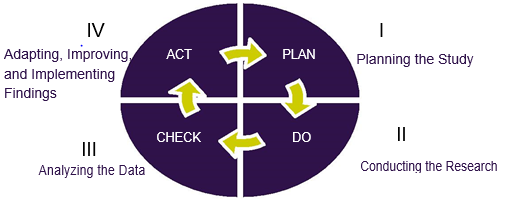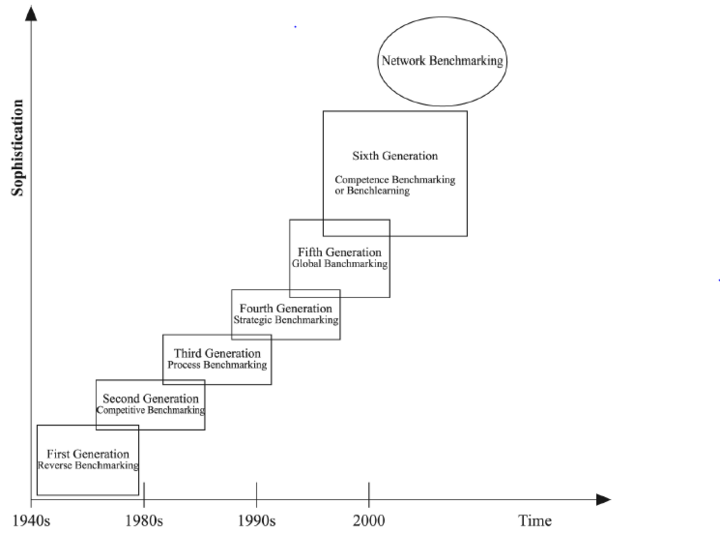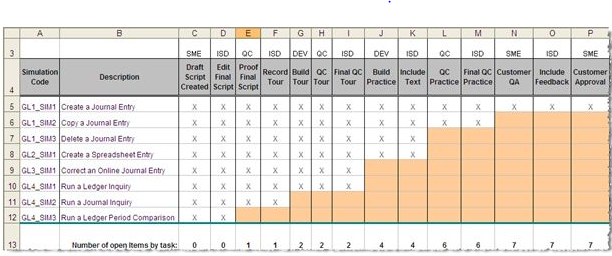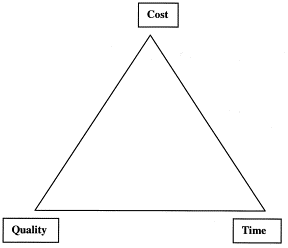Benchmarking in Project Management
Developed by Dimitrios Makris
Nowadays, project management tools and methodologies have been highly useful for organizations that seek to implement changes in order to increase their performance. Adding to that, organizations are constantly striving to find new opportunities to increase their effectiveness as much as possible. One of these opportunities is to examine the outcomes and the lessons learnt from various similar projects that have been completed in the market from similar organizations and thus, use benchmarking.
As a business term, benchmarking is the series of actions in order to compare a business' distinct processes, practices or procedures, to other businesses with similar activities, and have a leading role in the world market. Benchmarking is mainly used so that a company gains valuable information in pursuance of improving its performance and, as a natural outcome, to increase its competitiveness. Usually, there are different indicators that companies use to assess their performance during the process of benchmarking. These indicators, mainly focus on the aspects of time, cost and quality.
It has been proved that benchmarking against companies that have a leading role in the industry has effectively helped average organizations to improve their performance. [1] Based on that, this article will present how improvements in the performance of companies can be achieved by benchmarking projects. This article will firstly explore the general purpose of benchmarking. Then, it will be examined how the distinct types of benchmarking can be applied to the management of projects. Furthermore, there will be a discussion on what to benchmark and what aptitudes are needed to do so. Finally, an analysis about the limitations of benchmarking in project management will be held.
Contents |
Benchmarking in General
Definition
Benchmarking is a constant process of analysis and research, among the best performers, in order to extract useful information for improving the organizational or project performance of a company, and not just copying or imitating what others do to thrive. As Bent and Humphrey suggest about benchmarking, ‘‘Benchmarking is the technical core of the Total Quality Management (TQM) process. It identifies the quality of current personal skill levels and company procedures/methods, and then compares this quality with the latest state-of-the-art techniques’’. [2]
Another definition of benchmarking was suggested from the International Benchmarking Clearinghouse (IBC) Design Steering Committee, which concluded in 1992 that benchmarking is: “A systematic and continuous measurement process; a process of continuously measuring and comparing an organization’s business processes against business process leaders anywhere in the world to gain information which will help the organization take action to improve its performance ”. [3]
General Purpose of Benchmarking
It is clear from these definitions that benchmarking is not only a process in which performance, compared to others, can be measured, but also a tool to describe how notable performance can be accomplished. This kind of performance can be described by measures of performance indicators, called benchmarks. The activities that are used in order to achieve this performance are called enablers [4] and their main purpose is to analyze the logic for reaching this kind of notable performance. Usually, benchmarking studies are conducted by taking into account these two components and thus, it can be stated that benchmarks can be attained by acquiring the right enablers.
As part of the benchmarking process, many models and approaches have been used but they all take into consideration an iterative benchmarking process proposed by W.E Deming known as the “Deming Cycle”. The Deming cycle includes a minimum of four phases: Plan–Do-Check-Act. This is presented in Figure 1.
Types and Generations of Benchmarking
Common Types of Benchmarking
The types of benchmarking indicate what is compared when they involve comparisons that are closely associated with process, performance and strategic benchmarking. These are the three major types of benchmarking. Apart from that, when internal, functional, generic and competitive comparisons and approaches are used, then they usually refer to whom the organization is compared against. [5],[6] All these types of benchmarking are further analyzed in the table below.
| Types of Benchmarking | Definition |
|---|---|
| Performance Benchmarking | Comparison of products and services in order to determine how good an organization is if compared to competitors. |
| Process Benchmarking | Comparison of methods and processes that similar organizations use, in order to improve the processes in an organization. |
| Strategic Benchmarking | Comparison of the current organization’s strategy with other successful strategies from organizations in the market.
The organizations use this type of benchmarking to improve their competence or to spot new strategic choices. |
| Internal Benchmarking | Comparisons of the performance of different departments inside the same organization in order to find and apply the best practices and increase the overall performance of the organization. |
| External or Competitive Benchmarking | Comparison made against the “best” competition inside the same industry to compare products and services and find new practices. |
| Functional Benchmarking | Comparisons regarding particular functional areas in a company with functional areas of other companies. The purpose is to master a specific functional area instead of just improving separate processes. |
| Generic Benchmarking | Comparison of processes against generally accepted best standards regardless the type of industry. |
Evolution of Benchmarking Generations
Benchmarking has been characterized as a developing science and thus many generations can be identified. As it can be seen in Figure 2 [2], the first generation of benchmarking, called “Reverse Benchmarking”, was entirely focused on the comparisons based on products' characteristics, functionality and performance with similar products. Thus, it was mainly product-oriented. [7]
Furthermore, the second generation, or as called “Competitive Benchmarking”, involved comparisons of processes with those of the competitors. The “Process Benchmarking”, which was the third generation of benchmarking, suggested that comparisons were developed outside the environment of the organization. Adding to that, evaluations mostly targeted companies with recognized strong practices, regardless of the industry and the competitors. The fourth generation is referred as “Strategic Benchmarking” and is the systematic process of the assessment of numerous alternatives, the implementation of strategies and the improvement of performance. This can be achieved by trying to understand and adapt to successful strategies that external partners, who participate in an ongoing business alliance, use.
More specific, strategic benchmarking is about trying to compare a competitor's strategy to one's own inside the same market, and compare the features and performance of actual products. Although, as Gattorna and Walters [8] argue, unless the strategic direction of the addressed benchmark company is understood in depth, it is improbable that any comparison will have successful outcomes, especially when management strategies of projects are concerned.
The fifth generation or “Global Benchmarking” has to do with a global development and application of benchmarking, and thus is dealing with the globalization of industries. [9] This generation of benchmarking is helping organizations to identify who are the best in class and then, try to link with them. As it was suggested by some researchers [10], a few extensions of the model are starting to arise, and predictions that suggest a sixth and a seventh generation called “Benchlearning” and “Network Benchmarking” respectively are close on becoming a reality.
Benchmarking in Project Management
Improvement can be characterized as the primary driver behind any benchmarking initiative, including that of project management. As it can be seen in Figure 3, Maylor [11] presented the four distinct phases regarding the process of project management. In particular, the main idea behind “Develop the process” phase is that constant learning and improvement can be achieved by using information to improve the management process of any forthcoming projects, by evaluating the project progress and by learning from any previous experience. The improvement process can be split into two parts. The first one is "learn by doing" and the second one is "learn before doing". As far as the project progress is concerned, tools, such audit reviews, lesson learnt during the project and scorecards[3] -as it is presented in Figure 4, are vastly used. However, benchmarking is used to link “learn by doing” and “learn before doing” with the aim of learning and improving managerial processes of any future project.
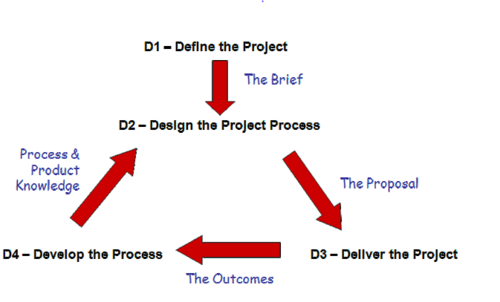
Figure 3: Maylor's project life-cycle phases
Furthermore, benchmarking can be applied during different phases of a project for distinct purposes. More specifically, it can be applied during the following phases:
- Early on the project. When benchmarking is applied early on, such as in project authorization, it can be used to identify features that may be closely bonded with possible future problems. Adding to that, it can be used to identify aspects of project management (e.g. Risk management in project portfolios) that require proper attention and precise handling so that the project leads to a favorable outcome.
- During the execution of the project. When applied during the project execution phase, benchmarking can be used as a useful project management tool that can guide decisions regarding the project.
- After the project is completed. Post-project benchmarking is mainly used in order to assess the performance of a project delivery system, to analyze the lessons learned during the project and to exploit feedback so that it can be used to enact benchmarks in future comparisons.
Post-project comparisons are usually the first comparisons that organizations use. As the benchmarking process builds, they progress to its earlier uses as well. As time goes by, when satisfactory data are available, trends can be analyzed so that a clear vision into the performance of project management systems can be provided.
What to Benchmark
Benchmarking is a method of assessing the quality of a project’s management and learning from it for the management of future projects. Based on literature, the project manager is responsible for orchestrating the management progress of a project. [12] Therefore, and as it will be analyzed afterwards, the project manager should be endowed with certain skills and competencies to achieve superior results in project management.
As the Project Management Institute stated in the Project Management Body of Knowledge [13], the effective project management should possess and master ten primary competencies. Competence can be defined as the knowledge, skills and personal aspects that bring about superior results or match performance standards. [14] Project managers are required to be highly effective, and possess knowledge of all the technical details of their jobs, as well as the ability to get things done. As a result, the ten primary competencies that should be mastered according to PMI are [4]:
- Project Scope Management
- Project Time Management
- Project Cost Management
- Project Integration Management
- Project Human Resource Management
- Project Communications Management
- Project Risk Management
- Project Procurement Management
- Project Quality Management
- Project Stakeholders Management
Project Success
In order to have a better overview of whether a project is successful or not -and thus use it as a benchmark, success needs to be measured. When the success is to be measured, then the so-called ‘‘Iron Triangle’’ -which is recognized as the cornerstone of project success evaluation- is used (Figure 5). As Atkinson [15] states: ‘‘cost, time and quality (the iron triangle) over the last 50 years have become inextricably linked with measuring the success of project management’’. [15] Atkinson claims though that these three factors that define this tool, will not signify whether the management of a project has been exemplary or not. He explains that these three estimations (especially time and cost) are put together at a time when the least amount of information is available regarding the project – typically in the planning stages.
It is logical to assume then that if the benchmarking process that focuses on these three criteria is translated carelessly, regarding time, budgeting and quality, it will probably be flawed.
Apart from that, Atkinson [15] also suggests the adoption of the ‘‘Square Root’’ model, in order to create a more holistic view of project management (Figure 6). He combines the three criteria of the iron triangle into a single touchstone and adds three supplementary criteria, which are information systems, benefits to the organization and benefits to the stakeholder community. The attributes comprising each of the four components include both tangible and in-tangible elements, which would increase the difficulty of initiating a benchmarking process. For instance, information systems usually consist of maintainability, reliability, validity and information-quality usage. Generally, the benefits to the organization are related to improved efficiency, improved effectiveness, increased profits, achievement of strategic goals, organizational learning and reduced waste. For the stakeholders point of view, the benefits are akin to satisfying customers and users, minimizing social and environmental impacts, achieving personal development and professional learning, and others.
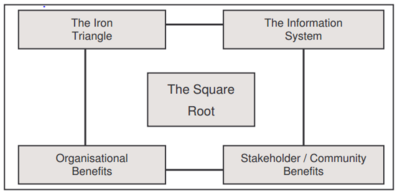
Figure 6: Atkinson's "Square Root" criteria for project management success
Even though the scope of Atkinson's method is logical, substantial disaggregation will still be needed for benchmarking the management of a specific project.
As other researchers claim [16], the key areas of interest when evaluating the management of a project, are effectiveness and efficiency. Efficiency can be defined as the maximization of the output for a given level of input while effectiveness is directed to the level of achievement of goals or targets.
Subsequently, there is a variety of sources and opinions on what to benchmark. Though, only if a common ground on what are the needed skills and competencies of a manager is created, will benchmarking become generally acceptable. So far, the only agreement is on an agreeable generic benchmark evaluation of project managers' competencies.
Metrics for Effective Benchmarking in Project Management
Taking into account what was presented above, it is clear that there are no universal metrics for the project management processes. It is therefore essential that each organization selects performance indicators that suit its own particular strategies and situations the best.
Some of the common metrics that are suggested for effective benchmarking in project management are [17]:
- Project Cost
Organizations should have a spherical knowledge on how much is invested in project management. To do that they must keep track of various cost factors such as:
• Salaries, wages and benefits of project managers and project support personnel
• Information technology costs of project management tools
• The amortized value of training, consulting, building rent, travel, etc.
- Project Schedule Performance
Another helpful metric is the Schedule Performance Index (SPI). SPI can be defined as the earned value, divided by the planned value delivered by project. It is a metric that mainly helps the organization to schedule in a more accurate way. Adding to that, the ability of an organization to estimate costs and schedule accurately enables it to make the most efficient use of its resources, both human and capital.
- Return on Investment (ROI)
The most suitable formula for project investment evaluation is by dividing net benefits by cost. The key point that makes this metric effective, is the placement of a dollar value on each unit of data that can be retrieved and applied to assess net benefits. More specific, this data can be contribution to profit, cost savings, increase in quality of output converted to a dollar value, etc. Costs could include project design and development costs, cost of resources, cost of travel and expenses, overhead etc.
- Staffing
Handling of people can be one of the most critical project management resources and define its overall effectiveness. It is vital for any organization to possess not only the optimal number of employees but also the appropriate personnel ratios among the people who are responsible for project management.
- Post-Project Reviews
Post-project reviews are also an important and widely used metric. As it was also stated above, project managers can gain valuable information, identify lessons learned and generally obtain feedback from any formal reviews of completed projects. All these information, can be used in the improvement of future projects.
- Alignment to Strategic Business Goals
It is vital for any organization to align its projects with its organizational strategy, if portfolio success is to be reached. This can be done by creating an accordance between project spending and corporate strategic goals, as well as the associated level of project delivery against plan, scope and budget.
- Customer Satisfaction
If a company is to earn customers loyalty against its competitors, then it is crucial to deliver consistent customer satisfaction. Customer satisfaction can be achieved if the customer expectations have been met, and if clients are pleased, based on the performance of projects.
Limitations
Benchmarking the management of projects has its own limitations that support the fact that is not always a good idea to introduce evaluation through benchmarking. First of all, projects are by nature unique and have a specific life-cycle. Hence, it is difficult to find common ground among them. The uniqueness of projects is mirrored in the way they are managed, which is something that increases the complexity to identify the best management practices among them.
Moreover, another limitation can be that benchmarking is lacking effectiveness when a problem that has not been previously recognized has to be encountered. If for instance a managerial aspect is facing a difficulty and the comparable partner has not experienced that kind of difficulty before, then it is most probable that a benchmarking process will not provide any feasible solution.
Furthermore, it is obvious that benchmarking is based on expense, meaning that it requires excessive time and cost of gathering and evaluating performance data. As a result, this can consume a vast number of resources and at the same moment waste a great amount of time. For example, the process of finding the right company to benchmark the right aspects of management, can be time and money consuming. Adding to that, benchmarking is based on sharing knowledge and creating trust among the distinct organizations which might in the end cultivate unwillingness to cooperate, and raise suspicions.
Different factors and their interrelationships during a project can also be a limitation, and have a significant effect on its management. It is almost impossible to manage all of these factors during a large and complex project and thus it is crucial to separate the important few for the trivial many. As a reflection, the manager should waste time to clearly identify the "key factors" that will impact the success of the project the most.
Finally, benchmarking has often been found problematic because it only highlights the performance gaps between organizations, without giving the reasons that led to these gaps. This can be explained by the fact that these performance gaps, identified through benchmarking, are more connected with the differences in the way the distinct organizations measure and track the performance of their systems. On the contrary, they do not focus that much on pointing out any significant inequalities on how a manager should control a specific project.
All these limitations though, can be counterbalanced by the various benefits that arise from benchmarking and can lead to reciprocal benefits for everyone involved in this process.
Conclusion
‘‘Considering the role of world-class performers through benchmarking and adopting their principles is just one tool in the improvement process’’. [11]
The above statement, is made in the context of gaining the maximum benefit from a project, not only in outcomes for the immediate project, but also by improving the performance of management in future projects. This maximum benefit can be partially obtained by giving effective evaluations regarding the quality of project management.
As it was mentioned earlier, there is no single benchmark that will cover all the aspects of project management evaluation. The only way to achieve optimal results, while benchmarking the management of a project, would be to use the right criteria for each aspect of the management process that undergoes evaluation.
Regardless of the various limitations that the use of effective benchmarking project management practices has, it is expected that this evaluation tool will be widely used in the near future. The markets are constantly changing, with speed and top performance being the main elements that characterize competition. [18] Customers nowadays are becoming more aware on what to expect, and as a result they raise their demand standards.
Furthermore, changes can be unexpected and difficult to measure, something that will eventually make it apparent for organizations to redesign and reconsider their processes, their products and their services. In such a volatile environment, they should be dexterous and agile in order to handle changes. That is where a manager should demonstrate its virtues, and work hand in hand with the organization to institute change. At the end of the day, evaluation is more than vital in pursuance of a positive change and successful projects.
One of the principal characteristics of project management is that a change is demonstrated in the system. Adding to that, evaluation gives project manager the opportunity to look at what was done well, what was done poorly and identify any future improvements that can be done in possible future projects. The nature of project management is that it is transitory and lays the ground for quick change but it is crucial to know where this will lead. Benchmarking as an evaluation tool can lead to this direction.
References
- ↑ Luu V.T, Kim S.Y and Huynh T.A. (2008), Improving project management performance of large contractors using benchmarking approach International Journal of Project Management, vol.26, pp. 758-769
- ↑ Bent J., Humphreys K. (1996), Effective project management through applied cost and schedule control, Marcel Dekker, New York
- ↑ American Productivity & Quality(APQC). (1992), Planning, Organizing, and Managing Benchmarking Activities: A User’s Guide, APQC, Houston, TX
- ↑ Camp, R. (1989), Benchmarking: The search for industry best practices that lead to superior performance, ASQC Quality Press, Milwaukee
- ↑ Andersen B. and Pettersen P. (1996), The Benchmarking Handbook, Chapman & Hall, UK
- ↑ Evans A. (1994), Benchmarking taking your organisation towards best practice, Business Library, Melbourne
- ↑ Watson G.H. (1993), Strategic benchmarking: How to rate your company’s performance against the world’s best, John Wiley, New York
- ↑ Gattorna J.L. and Walters D.W. (1996), Managing the supply chain a strategic perspective, MacMillan Press, Basingstoke
- ↑ Ramabadron R., James W. Dean Jr and James R.Evans (1997), Benchmarking and Project Management: a review and organizational model, Benchmarking: An international Journal, Vol. 4, Issue 1, pp. 47-58
- ↑ Kyro P. (2003), Revising the concepts and forms of benchmarking, Benchmarking: An international Journal, Vol. 10, Issue 3, pp. 210-225
- ↑ 11.0 11.1 Maylor H. (2005), Project management, 3rd Edition, Financial Times, London, UK
- ↑ Barber E. (2004), Benchmarking the management of projects: a review of current thinking, International Journal of Project Management, Vol. 22, Issue 4, pp.301-307
- ↑ Project Management Institute (2000), Guide to project management body of knowledge, PMBOK, Pennsylvania
- ↑ Crawford L.H. (2003), Assessing and developing the project management competence of individuals in J.R.Turner(Ed), People in Project Management, Gower, Aldershot, UK
- ↑ 15.0 15.1 15.2 Atkinson R. (1999), Project management: cost, time and quality, two best guesses and a phenomenon, it's time to accept other success criteria, International Journal of Project Management, Vol. 17, Issue 6, pp.337-342
- ↑ Belout A. (1998), Effects of human resource management on project effectiveness and success: toward a new conceptual framework, International Journal of Project Management, Vol. 16, pp.21-26
- ↑ Cooke-Davies T. et al (2003), Effective Benchmarking for Project Management, Courtesy of the Project Management Institute, Compliments of Microsoft Business Solutions, and Project Management Institute
- ↑ Razmi J. (2000), The application of graphical techniques in evaluating benchmarking partners, Benchmarking: An international Journal, Vol. 7, pp. 1-7
